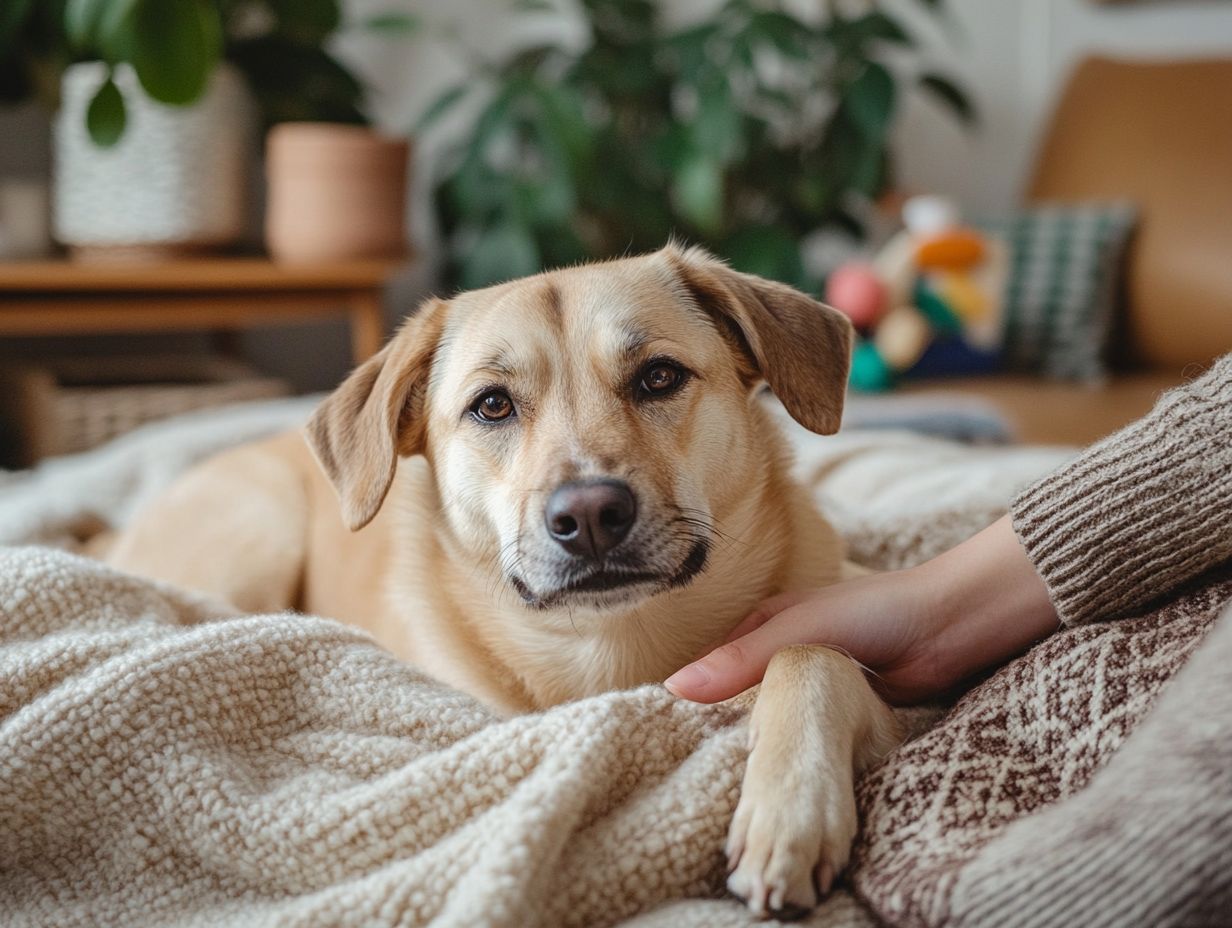How to Encourage Calm Behavior in Anxious Pets?
Do you notice your pet acting a bit off? Anxiety in pets is more common than you think. It can be a silent battle that significantly affects their well-being and behavior. Just like humans, animals experience stress and fear, which can show up in a variety of ways. Seeking help from resources like the AKC GoodDog Helpline can provide valuable insights.
This guide helps you recognize the signs of anxiety in your furry companions, from subtle behavioral cues to more evident physical indicators. It delves into effective strategies for creating a calming environment and employing positive reinforcement techniques that can benefit all dog owners.
It also outlines when to seek professional assistance from a trainer or veterinarian, as well as proactive measures to prevent anxiety in the first place. Armed with the right knowledge and approach, you can support your pets in leading happier, calmer lives.
Contents
- Key Takeaways:
- The Effects of Anxiety on Pets
- Identifying Signs of Anxiety in Pets
- Ways to Encourage Calm Behavior
- Seeking Professional Help for Anxious Pets
- Preventing Anxiety in Pets
- Frequently Asked Questions
- 1. How can I encourage calm behavior in my anxious pet?
- 2. What techniques can I use to calm my anxious pet, such as calming products like ThunderCloud or ThunderShirt?
- 3. How can I address my pet’s anxiety during car rides?
- 4. Can a change in diet help my pet’s anxiety?
- 5. How can I help my pet cope with separation anxiety?
- 6. Are there any natural remedies for calming anxious pets, and how do they align with modern practices?
Key Takeaways:

- Understanding your pet’s anxiety, including recognizing common questions, is key to addressing their behavior.
- Creating a safe and calming environment can greatly reduce your pet’s anxiety.
- Seeking professional help and being proactive in preventing anxiety can improve your pet’s overall well-being.
The Effects of Anxiety on Pets
Understanding the effects of dog anxiety is crucial for pet owners. Anxiety can greatly affect your dog s behavior and well-being.
You might notice that anxiety in pets can show up in various forms, potentially leading to destructive behaviors, excessive barking, or even withdrawal from social interactions. Spotting these signs early allows you to implement effective solutions and learn how to help your anxious pet feel safe, such as exercising your dog through tailored routines and calming games.
By recognizing your dog s body language and behavioral shifts, you can work towards building their confidence through confidence-building techniques and employing techniques that help your dog get used to scary situations. This fosters a more serene environment for your beloved companion.
Understanding Anxiety in Pets
Understanding anxiety in pets begins with recognizing specific anxiety triggers that can lead to distress and behavioral changes in your dog.
By pinpointing these triggers, you can more effectively address conditions like separation anxiety, where your dog struggles when left alone, or situational anxiety, which often surfaces during events like thunderstorms or fireworks. These situations may require professional guidance.
Implementing early training methods, such as dog training techniques, is essential in managing these anxieties. By employing positive reinforcement techniques, such as rewarding calm behavior with treats or praise, you create a more secure environment for your dog. Additionally, considering helpful tips for reducing pet anxiety can enhance your approach, similar to strategies used in training your puppy. This fosters trust and reinforces desirable behaviors, gradually alleviating anxiety symptoms and avoiding punishment.
Maintaining a consistent routine helps your dog feel secure. Providing a calm place for relaxation will further enhance your dog’s emotional well-being.
Identifying Signs of Anxiety in Pets
Recognizing the signs of anxiety in pets is crucial for dog owners who want to proactively tend to their dogs’ needs and behaviors. By addressing these concerns early, you can prevent them from escalating into more serious issues.
If you notice signs of anxiety in your furry friend, don t wait. Start creating a calmer environment today!
Behavioral and Physical Indicators

Behavioral and physical indicators of an anxious dog can manifest in various ways, ranging from excessive barking and destructive tendencies to more subtle cues like shifts in body language. These can be better understood through dog trainers.
For instance, you might notice your anxious dog pacing an almost incessant back-and-forth movement that signals their inability to find comfort. Hiding is another common behavior; your dog may seek solace in small, dark spaces to escape perceived stressors.
Physical signs such as trembling or shaking can be clear markers of anxiety, as can excessive panting, which may indicate distress even in a cool environment. This situation might call for a ThunderShirt (a snug-fitting garment that helps reduce anxiety) or other calming aids. Behaviors like avoiding eye contact or sporting a lowered tail provide vital insights into your dog’s emotional state, enabling you to better understand and address their needs with effective solutions like Rescue Remedy or Adaptil.
Ways to Encourage Calm Behavior
Encouraging calm behavior in your pets demands a varied approach that may include consulting animal behaviorists. You can also learn how to use calming products for anxious pets. Begin by establishing a serene space within your home—a sanctuary where they feel secure and can find mental stimulation through engaging toys.
Complement this environment with techniques that foster relaxation and a sense of safety, such as using chew toys to keep them engaged. This combination nurtures tranquility and strengthens the bond between you and your beloved companions.
Creating a Safe and Calming Environment
Creating a safe and calming environment for your dog is essential! It can change their life for the better. This environment offers both mental stimulation and a reassuring sense of security, essential for managing dog anxiety.
To achieve this, start by designating a quiet space in your home, complete with soft bedding and familiar toys, including options like a ZenCrate for a calming retreat. This sanctuary provides your pet with a cozy place whenever they feel overwhelmed.
Consider incorporating items that help calm pets, such as pheromone diffusers, anxiety wraps, or products like Noah s Harp to further enhance this peaceful atmosphere. Establishing a routine that includes regular exercise is also essential, encouraging activities that help to exercise your dog effectively.
Daily walks or play sessions not only help burn off excess energy but also strengthen the bond between you and your furry companion. This promotes mental well-being and tranquility in your shared space through dog sports.
Positive Reinforcement Techniques
Rewarding good behavior is essential for cultivating calm behavior in your dog, particularly when you’re training your puppy.
Unlike punishment, which often breeds fear and anxiety, this approach fosters a nurturing environment that encourages both learning and growth. It centers on rewarding the behaviors you want to see, making it a far more effective method for instilling good habits and promoting professional training.
For instance, you might use treats or verbal praise to motivate your puppy to sit or stay, reinforcing those behaviors you wish to encourage through methods recommended by dog trainers.
Seeking professional guidance through services like the AKC GoodDog Helpline can significantly enhance your training outcomes. Trainers can offer personalized strategies and insights. Techniques like clicker training or using your puppy’s favorite toys can also prove beneficial, contributing to a more compassionate and effective training experience that respects your puppy’s emotional needs.
Seeking Professional Help for Anxious Pets

When dealing with anxious pets, seeking professional help becomes essential! Don t wait! If your pet shows signs of anxiety, seek help immediately. This is especially important if behavioral issues continue to linger and impact their daily lives.
The expertise of a professional trainer, veterinarian, or animal behaviorist can prove invaluable in navigating these challenges effectively, especially when it comes to dog anxiety.
When to Consult a Veterinarian or Animal Behaviorist
Knowing when to consult a veterinarian or an animal behaviorist is essential for dog owners who notice persistent signs of anxiety that don’t seem to improve with basic training techniques or positive reinforcement.
This decision becomes even more pressing if your dog shows extreme fear during thunderstorms, engages in destructive behaviors, or withdraws from social interactions. These signs indicate a need for professional attention and can be early indicators that home-based solutions aren’t effective.
If your attempts at desensitization gradually getting your pet used to something that scares them or counter-conditioning yield little to no progress, it might be time to bring in professionals familiar with Dog Wizard methods.
A sudden change in behavior can signal underlying health issues that need immediate attention. Involving a qualified expert, like a vet, ensures that you re addressing your dog s emotional well-being comprehensively and effectively.
Preventing Anxiety in Pets
Act now! Preventing anxiety in pets is much easier than fixing it later. Focus on early training and being aware of potential anxiety triggers to create a loving environment.
By being proactive, you can create a more harmonious environment for your furry companions.
Proactive Measures and Tips
Implementing proactive measures can significantly reduce the likelihood of anxiety developing in your pets. Begin with best practices for pet anxiety training and utilize positive reinforcement and early training methods recommended by professionals.
Establish a structured routine that includes regular exercise to help your furry companion release excess energy and feel secure. Engage in activities like dog training classes or taking daily walks.
Incorporate positive reinforcement like treats or praise during training to encourage desired behaviors. This strengthens the bond of trust between you and your pet, especially in training anxious dogs.
Ensure a safe space at home with familiar toys and comfortable resting spots. This will contribute immensely to your dog’s overall sense of stability and comfort, enhancing their emotional resilience.
Frequently Asked Questions

1. How can I encourage calm behavior in my anxious pet?
To encourage calm behavior in your anxious pet, create a safe and comfortable environment. Provide a quiet space and include calming activities like regular exercise and playtime in their daily routine. You can also utilize tips on fostering a positive environment for anxious pets from the AKC GoodDog Helpline.
2. What techniques can I use to calm my anxious pet, such as calming products like ThunderCloud or ThunderShirt?
Use positive reinforcement and reward-based training. Additionally, consider techniques to calm anxious pets before training, such as practicing deep breathing exercises with them and trying calming pheromone products like Adaptil and Rescue Remedy.
3. How can I address my pet’s anxiety during car rides?
If your pet experiences anxiety during car rides, start by getting them used to the car gradually. Begin with short trips and increase the distance. Provide a comfortable blanket or toy to comfort them, just like in Dog Sports.
4. Can a change in diet help my pet’s anxiety?
A change in diet may help reduce anxiety in pets. Foods rich in omega-3 fatty acids, such as fish or flaxseed, can have a calming effect. For more insights, check out understanding anxious behaviors in pets. Always consult with a veterinarian before making any changes to your pet’s diet.
5. How can I help my pet cope with separation anxiety?
If your pet struggles with separation anxiety, gradually help them get used to being alone. Start by leaving them alone for short periods and slowly increase the duration.
Provide comforting items, like a piece of clothing that has your scent. This can help your pet feel more secure.
6. Are there any natural remedies for calming anxious pets, and how do they align with modern practices?
Yes, several natural remedies can help calm anxious pets. Creating calm spaces for anxious pets can enhance the effects of options like lavender oil, chamomile tea, and CBD oil.
These remedies can complement specific training techniques and expert advice. Always check with your veterinarian before trying new supplements.






